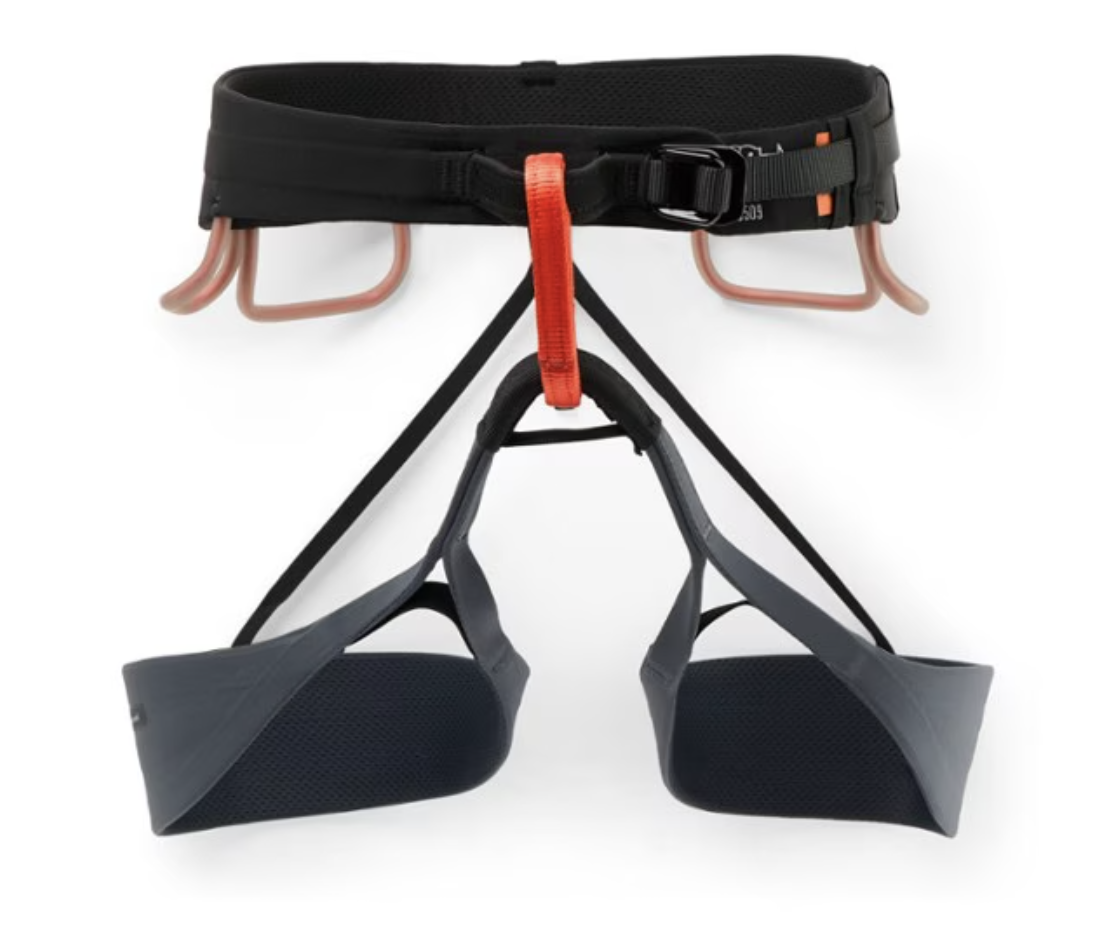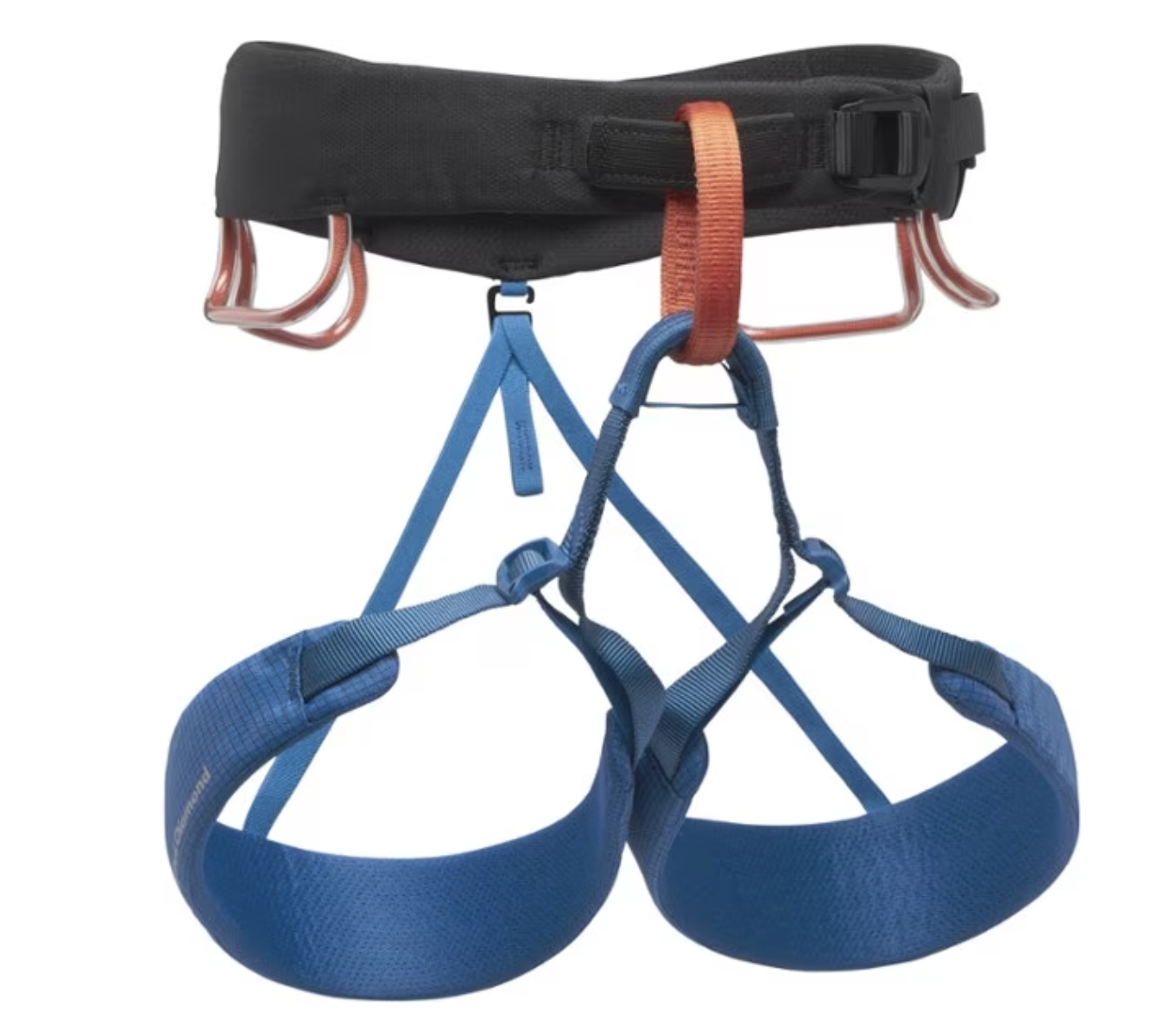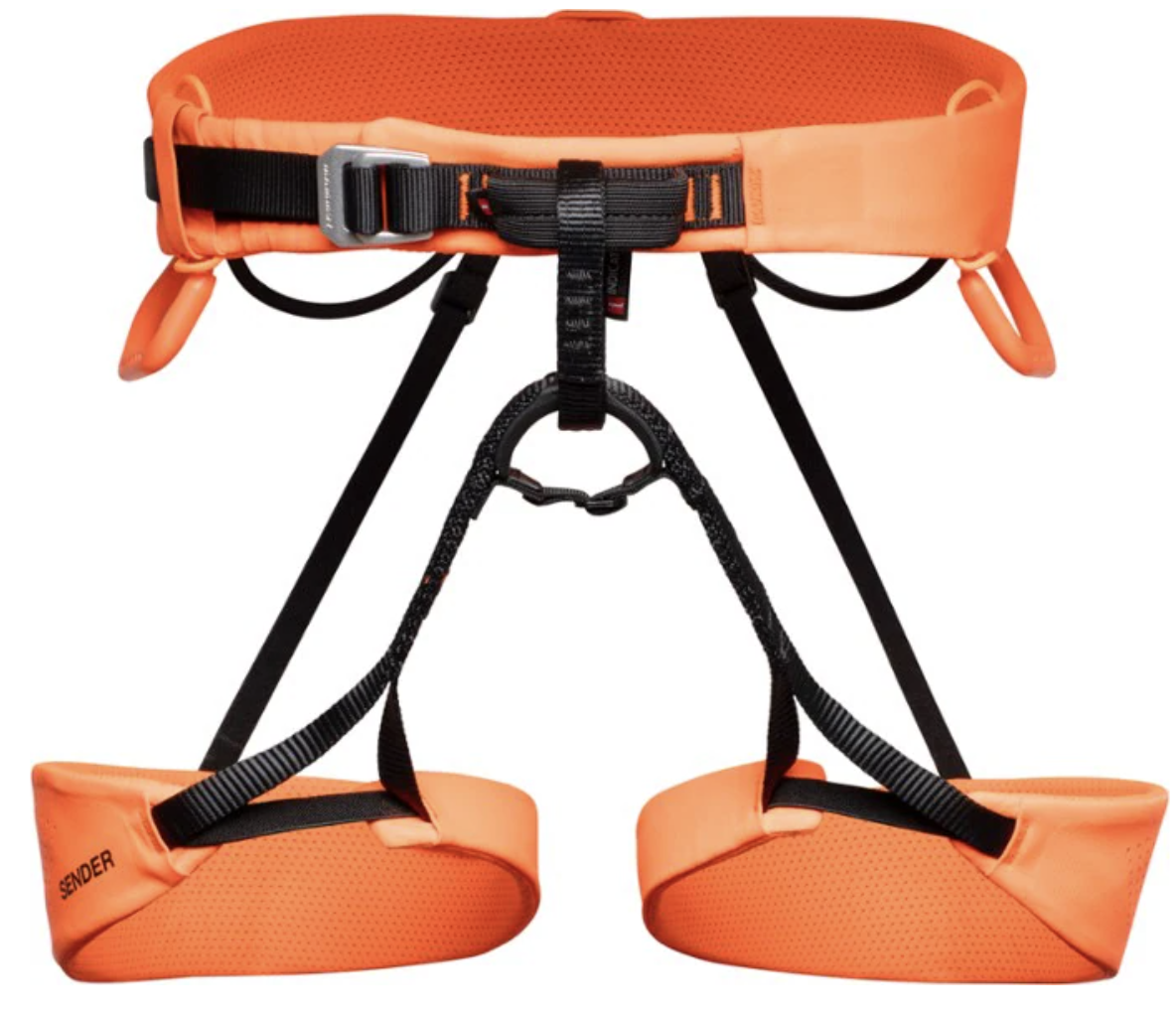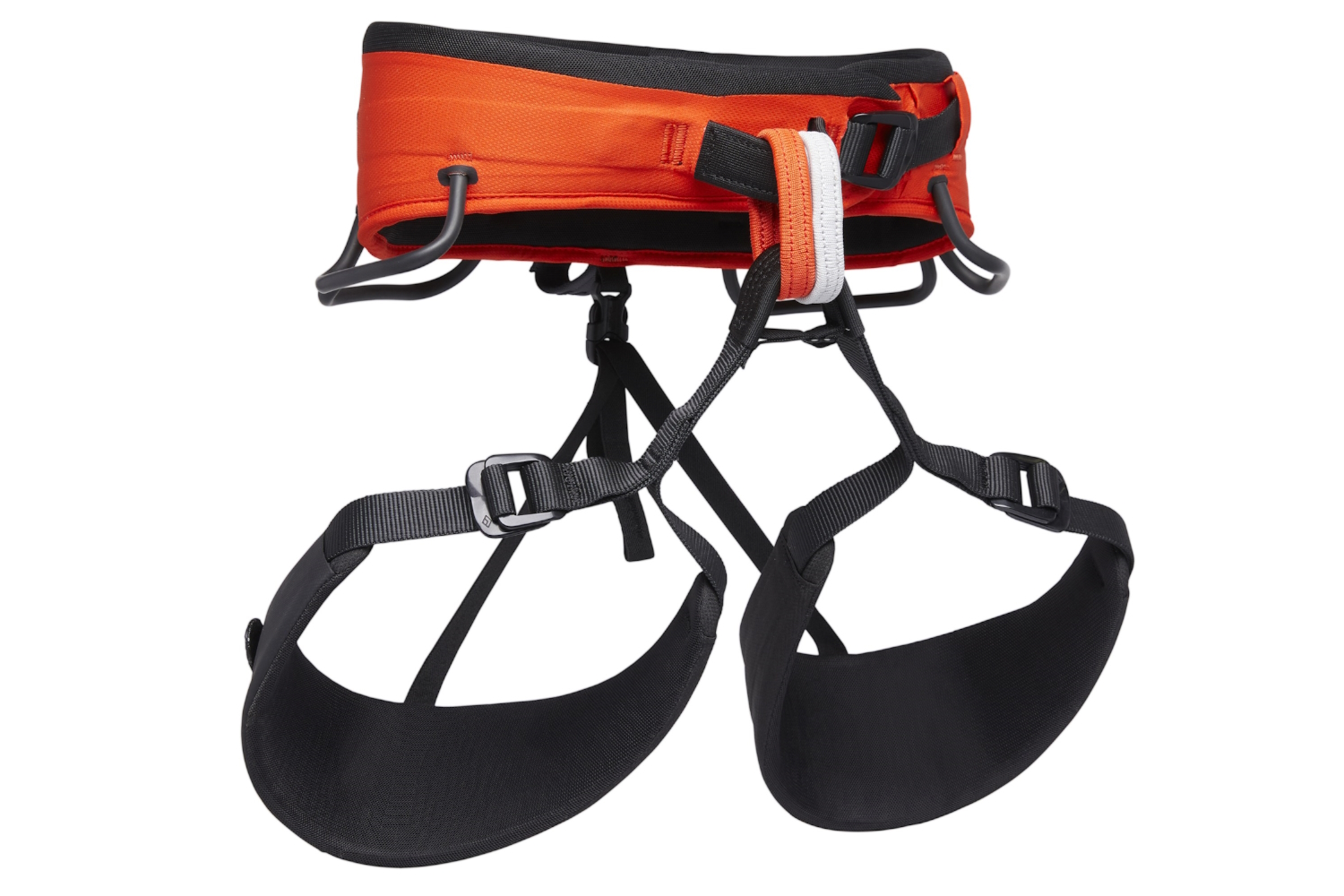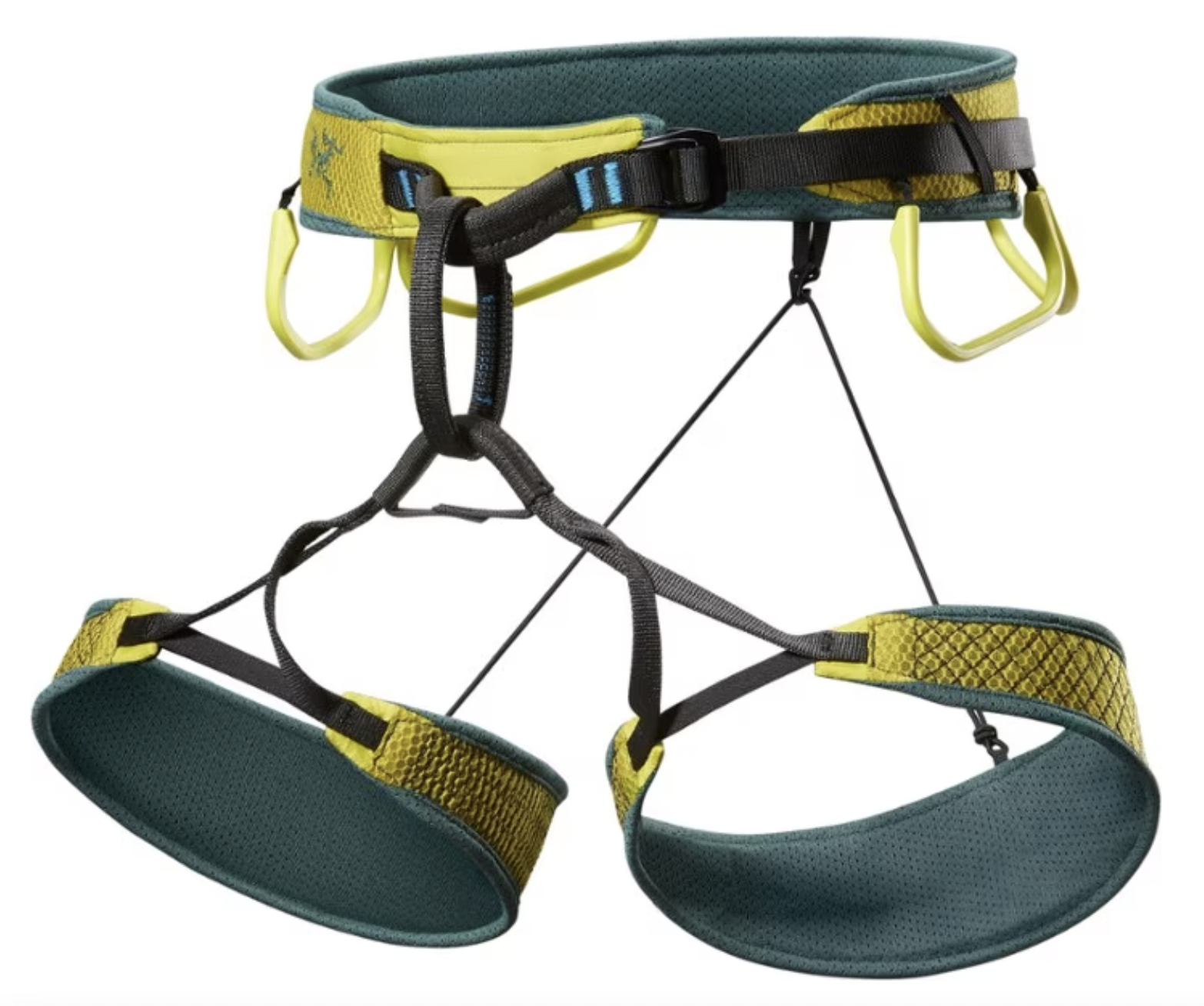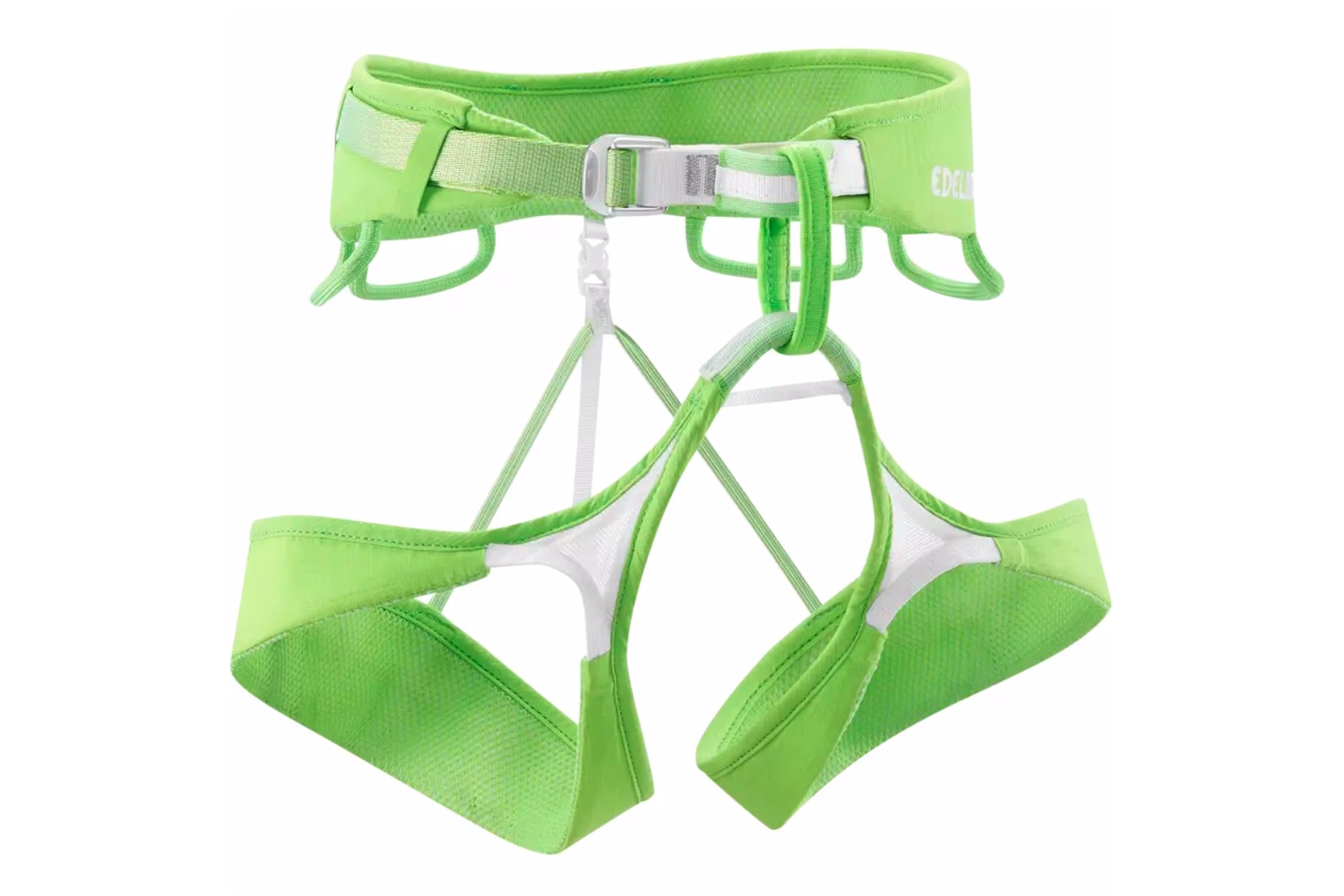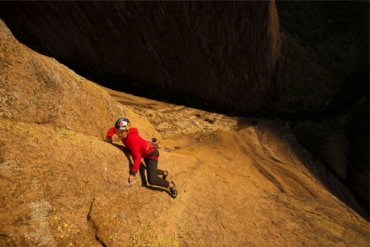From top roping in the gym to remote alpine expeditions, harnesses are an essential part of every climber’s kit. The GearJunkie team is made up of all sorts of climbers, enabling us to accurately test a variety of gear according to its intended use. The lead author of this article is Austin Beck-Doss, a dedicated climber who is currently based in the bolt-clipping haven of Lander, Wyo. Sport climbing is Austin’s primary pursuit, so he tends to climb in lightweight harnesses with minimal gear loops and padding.
Austin has managed to try out dozens of beefier harnesses while developing new routes and climbing big walls. Also contributing is senior editor and YOSAR veteran Matt Bento, who has spent hundreds of hours hanging in climbing harnesses during rescues, on big walls, and failed redpoint attempts.
On this list of the best climbing harnesses of 2025, we’ve included our favorites from a wide variety of categories. From novice climbers to trad masters, our list will include an option that suits your climbing needs.
Editor’s Note: This guide received an update on June 5, 2025. The Black Diamond Solution is our new overall favorite, and we’ve tested and reviewed the light and durable Mammut Sender harness. The Black Diamond Momentum is our new top budget pick. It’s a great choice for beginners and gym climbers, and it’s still a solid option for sport and trad climbing outdoors.
The Best Climbing Harnesses of 2025
- Weight: 11 oz.
- Best for: All-around climbing
- Key features: Fixed leg loops and simple, no-frills design
Pros
- Good value
- Versatile
- Durable
Cons
- Lacks specialty features
Black Diamond Momentum Harness
- Weight: 12.3 oz. (medium)
- Key features: Adjustable leg loops, bullhorn-shaped waist belt
- Best for: Gym climbing, sport climbing
Pros
- Affordable
- Great for beginners
- Quick adjusting leg loops
Cons
- Heavier padding doesn’t breathe well
- Not as packable as other models
- Small, non-rated haul loop
Black Diamond Zone
- Weight: 10.2 oz.
- Best for: Sport climbing, multipitch free climbing
- Key features: “Infinity” belay loop, large rear loop for extra gear or a tagline
Pros
- Great fit
- 4 pressure-molded gear loops
- Nice price
Cons
- Not the most durable
- Some climbers may prefer wider waists and leg loops for long days of hanging
Misty Mountain Titan
- Weight: 22.4 oz. (medium)
- Best for: Big-wall climbing, route development
- Key features: Six gear loops, rated haul loop, dual belay loops, removable leg loops
Pros
- Durable
- Highly supportive
- Adjustable
Cons
- Heavy
- Not ideal for free climbing
Blue Ice Choucas Light
- Weight: 3.1 oz. (medium)
- Best for: Mountaineering
- Key features: Ice clipper slots, two small gear loops, detachable leg loops
Pros
- Extremely light
- Packable
Cons
- Uncomfortable for prolonged hanging
- Minimal gear storage
More Great Climbing Harnesses, Field Tested
The following harnesses didn’t make the top of our list, but after many pitches, we can assure you they’re safe. comfortable, and worthy of your consideration.
- Weight: 11.2 oz. (medium)
- Best for: Sport climbing
- Key features: Plastic protectors at key wear points, ice screw attachments
Pros
- Lightweight
- Wear indicators
- Comfortable
- Nice price
Cons
- Rear gear loops are small and difficult to clip on the fly
- Weight: 1 lb. 5 oz. (medium)
- Best for: Trad climbing with a hefty rack, lengthy belays
- Key features: Wide waist belt, dual seamless belay loops, roomy gear loops, rated haul loop
Pros
- Lightweight relative to its padding and features
- Plenty of space for an Indian Creek mega rack
- Versatile double belay loops
Cons
- Marketed as a big wall harness, though it falls a little short for that application
- Weight: 1 lb., 2 oz. (medium)
- Best for: Trad and big wall climbing
- Key features: Dual belay loops, weight-bearing belay loops
Pros
- Extra belay loop comes in handy in certain multi-pitch situations
- Durable
Cons
- Heavy
- Weight: 10 oz. (medium)
- Best for: Sport climbing, multi-pitch trad climbing
- Key features: Four large gear loops, Warp Strength Technology pressure distribution
Pros
- Big gear loops
- Lightweight
- Packable
Cons
- Expensive
- Not as comfortable as our favorite old Arc’teryx harness
- Weight: 10.7 oz. (Size medium)
- Best for: Sport climbing
- Key features: Four gear loops, ice screw holder attachment
Pros
- Lightweight
- Soft feel
- Very breathable
- Super packable
Cons
- Rear gear loops are a little smaller than the competition
- Slim-fitting leg loops may not provide the best fit
- Weight: 9.2 oz (medium)
- Best for: Redpointing sport routes
- Key features: Lightweight gear loops, breathable waist loop
Pros
- Lightweight
- Relatively comfortable
- Breathable
Cons
- Minimal storage space on gear loops
Climbing Harness Comparison Chart
| Harness | Price | Weight | Best for | Key Features |
|---|---|---|---|---|
| Black Diamond Solution | $80 | 11 oz. | All-around climbing, gym climbing, beginners | Fixed leg loops, simple, no-frills design |
| Black Diamond Momentum | $65 | 12.3 oz | Beginner, sport climbing | Adjustable Leg Loops, Bullhorn-shaped waist belt |
| Black Diamond Zone Harness | $110 | 10.2 oz. | Sport climbing, ice, multi-pitch free climbing | “Infinity” belay loop, large rear loop for extra gear or a tagline |
| Wild Country Mosquito | $110 | 9.2 oz. | Redpointing sport routes | Lightweight gear loops, breathable waist loop |
| Misty Mountain Titan | $210 | 1 lb., 8.4 oz. | Big wall climbing, route development | Six gear loops, rated haul loop, dual belay loops, removable leg loops |
| Black Diamond Long Haul | $140 | 14 oz. | Aid climbing | Fifth gear loop for extra gear, abrasion-resistant “Super Fabric” |
| Blue Ice Choucas Light | $80 | 3.1 oz. | Mountaineering | Two zippered front pockets, zippered thigh pocket |
| Arc’teryx Skaha | $180 | 10 oz. | Sport climbing, multi-pitch trad climbing | Four large gear loops |
| Edelrid ACE | $130 | 10.7 | Sport Climbing | Four gear loops, Ice screw holder attachment |
| Metolius Safe Tech Harness | $130 | 1 lb., 2 oz. | Trad and big wall climbing | Dual belay loops, weight-bearing belay loops |
How We Tested the Best Climbing Harnesses
Our Expert Testers
Climber and writer Austin Beck-Doss is the original author of this guide. Strong and psyched, Austin put the majority of these harnesses to the test at his local cliffs, which just happen to be the world-class limestone crags surrounding Lander, Wyo. Carrying the guide forward is Matt Bento, a former member of the Yosemite Search and Rescue team with almost 20 years of climbing experience under his belt.
Our Testing Grounds
The best way to test these harnesses and get a picture of the overall user experience is to just go climbing. Beck-Doss spent hours in each model while working sport routes at Wild Iris and Sinks Canyon, and also made the long March into the Wind River range to evaluate the harnesses for multi-pitch trad climbing.
Bento lives in Bishop, Calif., where awesome alpine climbing is a 20-minute drive away. He also logs plenty of hang time in these harnesses, hang dogging on difficult sport climbs in the Owens River Gorge and Pine Creek, and occasionally bolting new routes.
Bench Testing
For solid comparisons, we weigh each harness and consider what they add to our total climbing kit, measure the size of the gear loops, and rack an assortment of cams and draws to see how they hang, how accessible they feel, and how many each gear loop can reasonably hold.
After a few months of use, we assess wear and damage and update our findings in this guide if we observe anything significant. Overall, climbing harnesses can stand up to a lot of abuse, and while you should regularly inspect your harness, we’ve been able to enjoy our favorite harnesses for many years before retiring them.
For more info, you can check out our guide to women’s-specific climbing harnesses and our harness fitting guide. We also have top-notch guides for men’s climbing shoes, women’s climbing shoes, and a deep dive into the best climbing ropes.

Buyer’s Guide: How to Choose a Climbing Harness
Before you purchase a climbing harness, it’s important to understand your needs as a climber.
Different harnesses are designed for different climbing applications. While any harness made by a reputable manufacturer is built to keep you safe, a carefully selected harness will offer much more than basic safety.
It’s important to select a harness designed for the kind of climbing you plan to do. For example, heavily padded harnesses are great for aid climbers or route developers, but they will be too heavy and bulky for casual sport climbing.
Similarly, a harness with tons of gear loops may be a good choice for big-wall trad climbing, but it may not be necessary for ski mountaineering. Our list of recommendations includes various types of harnesses, and our buyer’s guide can help you understand the differences between them.
Entry-Level and All-Around Harnesses
Climbing harnesses designed for all-around use are the most beginner-friendly. Instead of specializing in one specific discipline, all-around harnesses include features that apply broadly to multiple climbing styles.
For beginner climbers, these harnesses are a comfortable and affordable tool that allows for the exploration of different kinds of climbing. On this list, we recommend the Black Diamond Momentum and the Black Diamond Solution as excellent entry-level options.
While these models aren’t ultralight or packed with high-tech features, they’re perfect for top-roping at the gym, learning to lead outside, or venturing up your first multipitch route.
Sport Climbing
Harnesses built for sport climbing are lightweight, low profile, and performance-oriented. All-around harnesses can absolutely be used for sport climbing, too. However, they tend to be bulkier and heavier than most experienced sport climbers prefer.
Because harness weight is a consideration for this climbing discipline, sport climbing harnesses tend to have minimal metal buckles and fixed leg loops. Also, sport climbing harnesses commonly feature split webbing construction instead of a single piece of webbing covered in bulky foam.
Gear storage is not a major priority for sport climbing harnesses, and they usually come with either two or four scaled-down gear loops.
High-end sport harnesses should be considered a specialty piece of gear. They’re great for redpoint burns and projecting, but we don’t recommend them to climbers seeking versatility. The harnesses we recommend in this category are the Black Diamond Zone, the Arc’teryx Skaha and the Edlerid Ace.
Trad Climbing
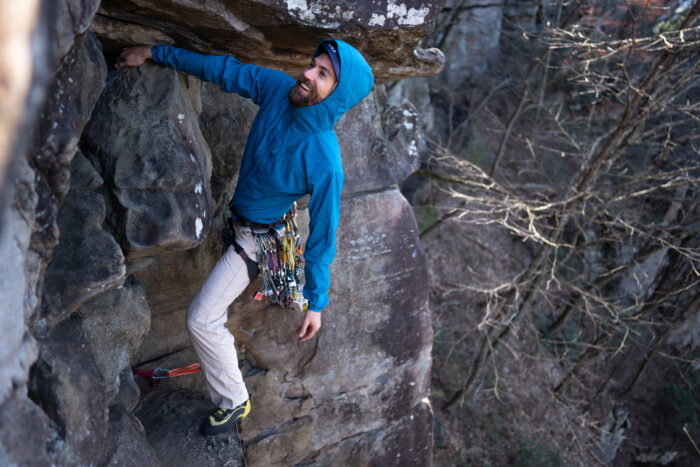
Trad climbers regularly carry a hefty rack of cams, nuts, and other gear via the gear loops on their harnesses. Compared to an entry-level or sport climbing harness, trad-specific models tend to have at least four large gear loops.
Whether you’re single-pitch cragging or multipitching, trad climbing often involves physical climbing techniques, including crack climbing and chimneying. A trad harness should be durable enough to hold up to these rugged sub-disciplines.
Because trad climbing commonly does involve multipitch routes, you’ll also want a model comfortable enough for all-day use. While sitting in a hanging belay, you’ll be glad to have wide and well-padded waist and leg loops.
A rear haul loop is a helpful feature too. Even if you don’t use it to haul a load, it can be a great place to clip a water bottle or a pair of approach shoes. On this list, the trad climbing harnesses we recommend are the Black Diamond Solution, the Black Diamond Long Haul, and the Metolius Safe Tech.
Alpine Climbing
Alpine climbing often involves long approaches, long multipitch routes, tricky protection, and less-than-ideal rock quality. An alpine climbing harness offers most of the same features as a trad climbing harness. The key difference is that alpine harnesses typically include features geared toward glacier travel and ice/mixed climbing.
In addition to at least four large gear loops, alpine harnesses usually have ice clipper slots, which are helpful for carrying ice screws. When traveling in the alpine, you’ll likely experience severe temperature fluctuations in a single day. Adjustable leg loops can expand to accommodate additional lower body layers when necessary.
Most alpine climbers aim to move light and fast, so many harnesses in this category are streamlined and packable. On our list, the best alpine harness is the Blue Ice Choucas.
Big-Wall Climbing
Big-wall climbing harnesses are all about comfort, gear storage, and support. For most people, big wall climbing is a slow and laborious process that involves a whole lot of hanging around in a harness.
Compared to any other type of harness, the waist and leg loops on a big wall model are extremely padded and burly. A true big wall harness has two belay loops, at least four large gear loops, and a load-bearing haul loop.
Though these beefy harnesses aren’t ideal for other styles of climbing, they’re an essential item for slogging up the wall in true big-wall style. On this list, we recommend the Misty Mountain Titan for big-wall climbing.

Mountaineering
Of all the categories of climbing harnesses, mountaineering models are the most lightweight. Most of the time, mountaineering involves lots of walking, hiking, and low-angle climbing on snow and ice. For this reason, these harnesses need to be comfortable for walking in and also need to be easy to put on and take off.
Removable leg loops are a great feature for ski mountaineering, specifically. Because falling is generally not a safe option in a mountaineering setting, these harnesses are not padded to comfortably cushion a fall. Sure, these harnesses can safely catch you, but it isn’t going to feel good.
Minimalism is the name of the game with mountaineering harnesses, and they tend to be less expensive than more feature-packed styles. On this list, the mountaineering harness we recommend is the Blue Ice Choucas.
Parts of a Climbing Harness
The basic parts of every climbing harness are the waist loop, leg loops, belay loop, and gear loops. Every harness on our list includes these fundamental features, no matter which climbing discipline it’s designed for. Beyond the essentials, harnesses may also have additional features such as a haul loop and ice clipper slots.

Waist and Leg Loops
The waist loop of a climbing harness should fit snugly around your waist and sit just above your hip bones. Most waist loops can be adjusted using a system of webbing and buckles. Many harnesses come with a similar buckle adjustment system on each leg loop.
Harnesses with fixed leg loops are usually built for high-end sport climbing. It’s very important that your waist and leg loops fit properly, and we recommend trying a harness on before purchasing.
Belay Loop
The belay loop is made of very strong nylon or Dyneema webbing and connects the waist loop to the leg loops. While belaying or rappelling, this loop is used to attach yourself to the rope and the greater climbing system.
Lightweight harnesses for sport climbing or mountaineering will have thinner belay loops, while all-around and trad climbing harnesses will have thicker loops. Many big-wall harnesses, like the Misty Mountain Titan, include two belay loops for extra versatility. Because your belay loop is a key part of the climbing system, you should check it regularly for wear.
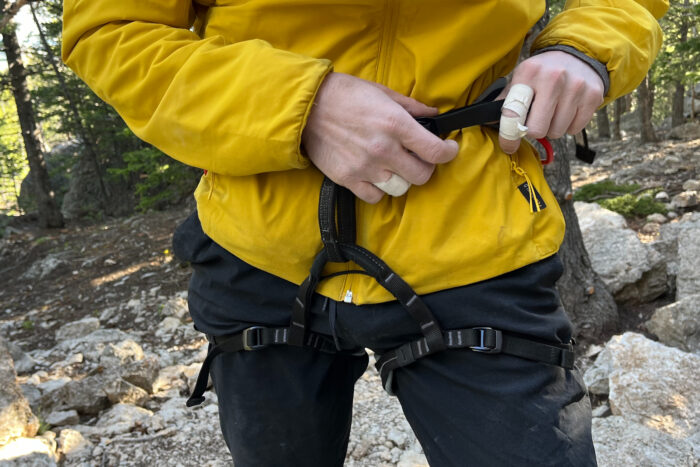
Gear Loops
Every harness will include at least two gear loops where you can conveniently hang items including quickdraws, cams, a jacket, a water bottle, and so on. The more gear-intensive and technical the climbing, the more gear loops you’ll need.
A harness with fewer than four gear loops is a specialty item and is probably designed for high-end sport climbing or mountaineering. Most all-around and entry-level harnesses come with four gear loops, which is plenty for gym climbing and single-pitch climbing.
For multipitch climbing, the addition of a fifth gear loop or haul loop is often useful. Big wall climbing requires lots of gear, and many big-wall harnesses have more than four gear loops.
Haul Loop
A haul loop is a small attachment point located at the back of a climbing harness. This feature is not necessary for gym climbing or single-pitch climbing.
For multipitch or big-wall climbing, look for a haul loop rated to full strength so you can use it to haul heavy loads. While actively climbing, a haul loop can be a convenient place to store an extra layer or a water bottle.
Ice Clipper Slots
Harnesses with ice clipper slots are specifically designed for ice climbing. They’re primarily used to carry ice screws.
Materials and Construction
As of 2025, climbing harnesses have evolved into lightweight, comfortable, and exceptionally strong pieces of gear. Still, as new materials and technology come to the forefront, harnesses continue to improve. In today’s market, there are two primary types of harness construction: foam and split webbing.

Foam Harnesses
Foam harnesses are built on a single piece of high-strength webbing embedded in layers of cushy foam. While the webbing gives this kind of harness its load-bearing ability, the foam provides support and comfort.
A well-constructed foam harness effectively disperses your weight while falling or hanging. Foam offers ample padding, and it is still the standard for harnesses built for comfort, including most entry-level and big-wall harnesses. On this list, BD Momentum and the Metolius Safe Tech.
However, foam and webbing construction does have some disadvantages. Foam is an insulator and does not breathe well. In warm weather, these harnesses can feel hot and sweaty.
Foam also wears out over time, and the more you climb in it, the less comfortable it will become. For experienced sport and trad climbers, foam harnesses are no longer the best option on the market.
Split Webbing Harnesses
Though foam and webbing harnesses have been the standard for several decades, more and more climbers are turning to split webbing harnesses.
Instead of a single piece of webbing covered by foam, split webbing harnesses feature a web-like matrix of high-strength materials. By spreading out the load-bearing materials, these harnesses are able to distribute pressure more evenly.
On split webbing harnesses, very little padding is required to create a comfortable fit. Split webbing harnesses tend to last longer than foam options, and many climbers find they offer a comfort advantage too.
The tradeoff is split webbing harnesses are considerably more expensive. However, split webbing is clearly the future of harness technology, and many of our favorite harnesses fit into this category. The Black Diamond Solution is a high-quality split webbing harness.
Harness Sizing

It’s very important that your climbing harness is properly fitted. Ultimately, the best way to find a good fit is to try a harness on before purchasing. Every harness and every person have unique shapes and dimensions, and the process of identifying the perfect match can involve some trial and error.
A properly fitted harness will feel snug and sit just above the hips. The harness should be tight but not uncomfortably so. It’s okay to be able to fit a finger or two between your body and the harness.
The leg loops should sit semi-snugly around your mid-thigh. It’s good to maintain a little wiggle room in your leg loops, as they can cut off circulation if they are too tight. While all harnesses include adjustable waist loops, not all include adjustable leg loops.
If you plan to climb in alpine conditions where you’ll need to change your lower body layers often, adjustable and/or removable leg loops are a must. Leg loops come with thin elastic straps that attach to the waist loop along the backside of the thighs. These are often releasable for easy bathroom breaks.
Durability
Depending on what kind of climbing you do — and how often you do it — a harness can last anywhere from a few months to multiple years. Because sport climbing tends to involve less contact between your harness and the rock, sport harnesses can be relatively thin.
Trad and aid climbing involve techniques such as offwidth and chimneying, which require direct contact between your body and the rock. Most trad and aid harnesses are made from burly materials.
Though the ultralight innovations sweeping the climbing market are exciting, it’s important to remember lighter materials do generally come with a decrease in durability. If you choose to buy a super-low-profile model, you should also be aware it probably won’t last as long as more robust options.
When to Retire Your Harness
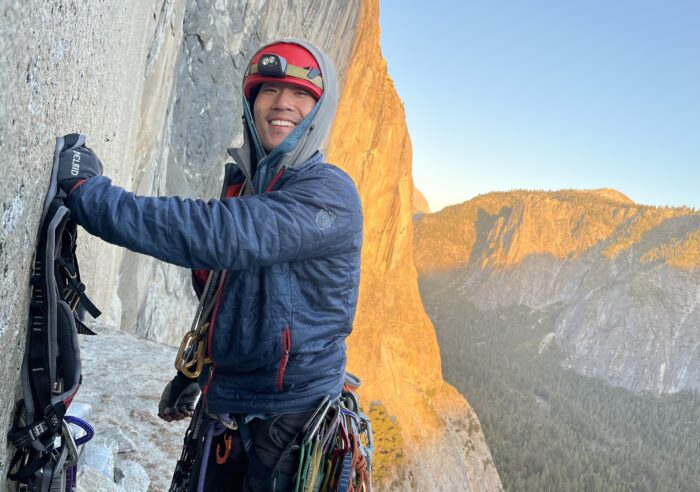
Just like a climbing rope, a harness should be regularly inspected for signs of wear. Pay extra attention to the weight-bearing components, including the tie-in points, belay loop, waist loop, and leg loops. Look carefully for fraying, fuzziness, or any signs of abrasions.
The belay loop or tie-in points are usually the first parts of a harness to wear out. The Mammut Sender harness has plastic covering the point on the harness where the belay loop rubs the leg loop attachment points, effectively negating this common area of wear.
If you’re not sure whether your harness needs to be retired, look up the manufacturer’s instructions for care and maintenance. Generally, we advise conservative decisions regarding whether a harness is still safe to use. If you have doubts about the condition of your harness, purchase a replacement.
Weight
Whether you’re wearing it or hauling it in your pack, you’re going to spend a lot of time carrying your harness around. Lightweight harnesses are generally associated with increased performance.
For entry-level climbers, weight is not as important as comfort. However, for climbers working to push themselves and improve — especially in the sport climbing discipline — minimal weight is preferred.
Though lightweight harnesses work great for sport climbing and mountaineering, other disciplines call for something a little heavier. Big wall harnesses with their numerous gear loops and maximal comfort are rightfully heavy.
On this list, we’ve included incredibly light harnesses like the Wild Country Mosquito, which weighs 9.2 ounces. On the other end of the spectrum, we also recommend the thick and burly Misty Mountain Titan, which weighs a whopping 22.4 ounces.
Price & Value
The harnesses in our guide range from $65 to $210 in price. Our favorites fall somewhere in the middle. Depending on what type of climbing you like to do, you may not need to pay top dollar for a climbing harness. While comfort and features get a little better as you pay more, safety is consistent throughout the price tiers.
Budget
The Black Diamond Momentum ($65) is the least expensive harness in our lineup. It has all the basic features you need for a day at the crag or even a long multipitch. Cost savings come from the traditional swami-style waist belt, that’s essentially a piece of webbing for safety attached to some padding for comfort. More expensive models distribute pressure more evenly and are more comfortable.
Mid Tier
Most climbers (and pro climbers) are rocking a moderately priced harness, with $80 being the sweet spot. The Mammut Sender ($90), the Black Diamond Zone ($99), and the Black Diamond Solution ($80) are all excellent choices. They sport the full allotment of gear loops, rear loops for a tagline, plus waistbelts and leg loops that distribute weight more evenly than basic webbing with padding.
Premium
Paying top dollar won’t necessarily make your harness more comfortable or any safer, but it does get you some premium features. The Misty Mountain Titan ($210) is heavily padded and has five gear loops. It’s geared toward big wall climbing.
Misty Mountain is a small company out of North Carolina that has produced quality climbing soft goods like harnesses and webbing for decades and offers some pretty unique, custom features if you order through their website.
The Black Diamond Long Haul ($140) is also designed with the big stone in mind, has a whopping six gear loops, and is constructed from a more abrasion-resistant material. Both are great options but overkill unless you spend a lot of time aid climbing or developing new sport routes.
Finally, the Arc’teryx Skaha ($180) has four large gear loops, a great load distribution system, and is super lightweight and packable. It’s a good harness for folks who like to free climb and want to keep the weight down on long approaches, but the weight savings will cost you.
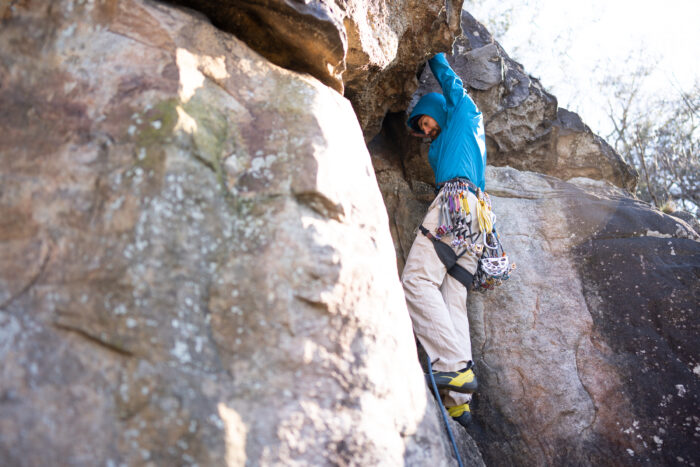
Frequently Asked Questions
The best climbing harness is the one that suits your current and future needs as a climber. If you’re just starting out, look for a harness that fits well and feels comfortable, as comfort is the top priority for beginners.
There are many types of climbing and many kinds of climbers. Choosing the perfect harness may require some patience and trial and error.
Like all load-bearing climbing gear, harnesses are rated and certified to hold a certain force, measured in kilonewtons (kN). To make a long explanation about forces and materials short, climbing harnesses are plenty strong to handle various climbing scenarios, including falls.
All climbers should be aware only certain parts of the harness are certified. In climbing systems, we rely on the strength of the belay loop, tie-in points, and waist loop. Some harnesses, like the Metolius Safe Tech, also include rated haul loops and gear loops.
A worn-out harness can lose its strength, and it’s important to routinely check your harness and other climbing gear for signs of wear.
Depending on the type and frequency of use, climbing harnesses can last anywhere from a few months to multiple years. Generally, harnesses with more durable materials and a bulkier build will last longer than ultralight and low-profile options, though many factors make it difficult to predict the lifespan of a climbing harness.
We consider all of the harnesses on this list to offer an appropriate amount of comfort for their intended application. With that said, most climbing harnesses are not as comfortable as a pair of sweatpants — it’s usually a relief to remove your harness at the end of a climbing session.
On this list, some harnesses, including the Misty Mountain Titan, are built for comfort and offer more support while hanging or belaying. Other options, like the ultralight Wild Country Mosquito, are less padded and quickly become uncomfortable while sitting or hanging.

The Best Climbing Harnesses for Women in 2025
We tested and reviewed the best climbing harnesses for women, including top picks from Black Diamond, Petzl, Metolius, and more.

The Best Climbing Shoes of 2025
Aside from the ice climbers, mountaineers, and Charles Albert, every climber needs a pair of reliable climbing shoes.

